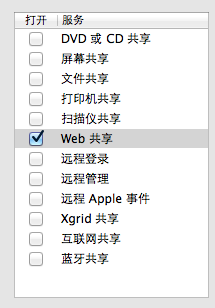由于最近需要布置mantis用来进行bug追踪,在此记录其过程。
由于PHP apache环境在Mac OS上是自带的,所以不需要另处下安装包,只需要简单配置一下即可。
首先打开终端输入命令:
sudo vim /etc/apache2/httpd.conf
其中有一行是这样的
#LoadModule php5_module libexec/apache2/libphp5.so
将前面的#号去掉。
然后打开系统偏好设置中的共享,将web共享勾上,如下图

重启apache, 命令如下:
sudo apachectl restart
这样就可以在浏览器中输入http://localhost/,如果出现
It works!
说明成功配置php环境
下面来配置MySql环境。
首先下载MySql的dmg安装包。下载地址在:http://dev.mysql.com/downloads/mysql/
打开dmg文件,里面有三个安装项,在此我三个都安装,MySQLStartupItem.pkg安装后,mysql会随系统启动而自启动,MySQL.prefPane表示可以在系统偏好设置中看到mysql选项,还有一个就是mysql的安装项。
这样一来就安装成功了,在系统偏好设置中打开mysql,并将服务开启。安装好后默认的用户名是root,密码为空。为了安全,我们设置一个密码。
打开终端,如果你输入mysql提示没有这个命令,那么需要配置mysql bin目录的环境变量。目录是,/usr/local/mysql/bin/, 将其加入到PATH变量中。在这儿我介绍另一种方法,
在终端中输入
sudo vim /etc/bashrc
然后在其中加入
#mysql
alias mysql='/usr/local/mysql/bin/mysql'
alias mysqladmin='/usr/local/mysql/bin/mysqladmin'
这样一来,在终端中输入mysql就有这个命令了, 其实它与我们C/C++中的宏定义有点类似,别名代替的作用。
接着我们修改root的密码,命令如下:
mysqladmin -uroot password 12345
这样就将root的密码改为了12345.
要管理Mysql,如果用命令行比较麻烦,开源的phpMyAdmin采用C/S的模式,方便管理。接着我们就装一个phpMyAdmin. 它是由php开发的,下载地址是:http://www.phpmyadmin.net/home_page/downloads.php
将下载下来的解压放在/Library/WebServer/Documents/目录下,完整的目录为:/Library/WebServer/Documents/phpmyadmin/,那么命令行进入这个目录,
再输入命令:
cp config.sample.inc.php config.inc.php
vim config.inc.php
按照下面进行修改:
$cfg['blowfish_secret'] = '';//用于Cookie加密,随意的长字符串
$cfg['Servers'][$i]['host'] = '127.0.0.1';//MySQL守护程序做了IP绑定
现在可以在浏览器中输入URL:http://localhost/phpmyadmin/
用服名为:root
密码为你设置的密码。
就可以login到mysql的管理界面。
好了,以上就是在MAC OS中配置PHP+MYSQL环境的全部内容了,希望小伙伴们能够喜欢。
 PHP Performance Tuning for High Traffic WebsitesMay 14, 2025 am 12:13 AM
PHP Performance Tuning for High Traffic WebsitesMay 14, 2025 am 12:13 AMThesecrettokeepingaPHP-poweredwebsiterunningsmoothlyunderheavyloadinvolvesseveralkeystrategies:1)ImplementopcodecachingwithOPcachetoreducescriptexecutiontime,2)UsedatabasequerycachingwithRedistolessendatabaseload,3)LeverageCDNslikeCloudflareforservin
 Dependency Injection in PHP: Code Examples for BeginnersMay 14, 2025 am 12:08 AM
Dependency Injection in PHP: Code Examples for BeginnersMay 14, 2025 am 12:08 AMYou should care about DependencyInjection(DI) because it makes your code clearer and easier to maintain. 1) DI makes it more modular by decoupling classes, 2) improves the convenience of testing and code flexibility, 3) Use DI containers to manage complex dependencies, but pay attention to performance impact and circular dependencies, 4) The best practice is to rely on abstract interfaces to achieve loose coupling.
 PHP Performance: is it possible to optimize the application?May 14, 2025 am 12:04 AM
PHP Performance: is it possible to optimize the application?May 14, 2025 am 12:04 AMYes,optimizingaPHPapplicationispossibleandessential.1)ImplementcachingusingAPCutoreducedatabaseload.2)Optimizedatabaseswithindexing,efficientqueries,andconnectionpooling.3)Enhancecodewithbuilt-infunctions,avoidingglobalvariables,andusingopcodecaching
 PHP Performance Optimization: The Ultimate GuideMay 14, 2025 am 12:02 AM
PHP Performance Optimization: The Ultimate GuideMay 14, 2025 am 12:02 AMThekeystrategiestosignificantlyboostPHPapplicationperformanceare:1)UseopcodecachinglikeOPcachetoreduceexecutiontime,2)Optimizedatabaseinteractionswithpreparedstatementsandproperindexing,3)ConfigurewebserverslikeNginxwithPHP-FPMforbetterperformance,4)
 PHP Dependency Injection Container: A Quick StartMay 13, 2025 am 12:11 AM
PHP Dependency Injection Container: A Quick StartMay 13, 2025 am 12:11 AMAPHPDependencyInjectionContainerisatoolthatmanagesclassdependencies,enhancingcodemodularity,testability,andmaintainability.Itactsasacentralhubforcreatingandinjectingdependencies,thusreducingtightcouplingandeasingunittesting.
 Dependency Injection vs. Service Locator in PHPMay 13, 2025 am 12:10 AM
Dependency Injection vs. Service Locator in PHPMay 13, 2025 am 12:10 AMSelect DependencyInjection (DI) for large applications, ServiceLocator is suitable for small projects or prototypes. 1) DI improves the testability and modularity of the code through constructor injection. 2) ServiceLocator obtains services through center registration, which is convenient but may lead to an increase in code coupling.
 PHP performance optimization strategies.May 13, 2025 am 12:06 AM
PHP performance optimization strategies.May 13, 2025 am 12:06 AMPHPapplicationscanbeoptimizedforspeedandefficiencyby:1)enablingopcacheinphp.ini,2)usingpreparedstatementswithPDOfordatabasequeries,3)replacingloopswitharray_filterandarray_mapfordataprocessing,4)configuringNginxasareverseproxy,5)implementingcachingwi
 PHP Email Validation: Ensuring Emails Are Sent CorrectlyMay 13, 2025 am 12:06 AM
PHP Email Validation: Ensuring Emails Are Sent CorrectlyMay 13, 2025 am 12:06 AMPHPemailvalidationinvolvesthreesteps:1)Formatvalidationusingregularexpressionstochecktheemailformat;2)DNSvalidationtoensurethedomainhasavalidMXrecord;3)SMTPvalidation,themostthoroughmethod,whichchecksifthemailboxexistsbyconnectingtotheSMTPserver.Impl


Hot AI Tools

Undresser.AI Undress
AI-powered app for creating realistic nude photos

AI Clothes Remover
Online AI tool for removing clothes from photos.

Undress AI Tool
Undress images for free

Clothoff.io
AI clothes remover

Video Face Swap
Swap faces in any video effortlessly with our completely free AI face swap tool!

Hot Article

Hot Tools

Dreamweaver Mac version
Visual web development tools

SublimeText3 Mac version
God-level code editing software (SublimeText3)

WebStorm Mac version
Useful JavaScript development tools

Atom editor mac version download
The most popular open source editor

DVWA
Damn Vulnerable Web App (DVWA) is a PHP/MySQL web application that is very vulnerable. Its main goals are to be an aid for security professionals to test their skills and tools in a legal environment, to help web developers better understand the process of securing web applications, and to help teachers/students teach/learn in a classroom environment Web application security. The goal of DVWA is to practice some of the most common web vulnerabilities through a simple and straightforward interface, with varying degrees of difficulty. Please note that this software






